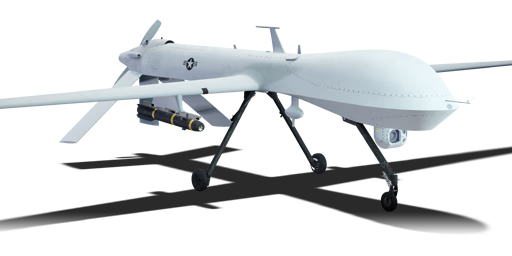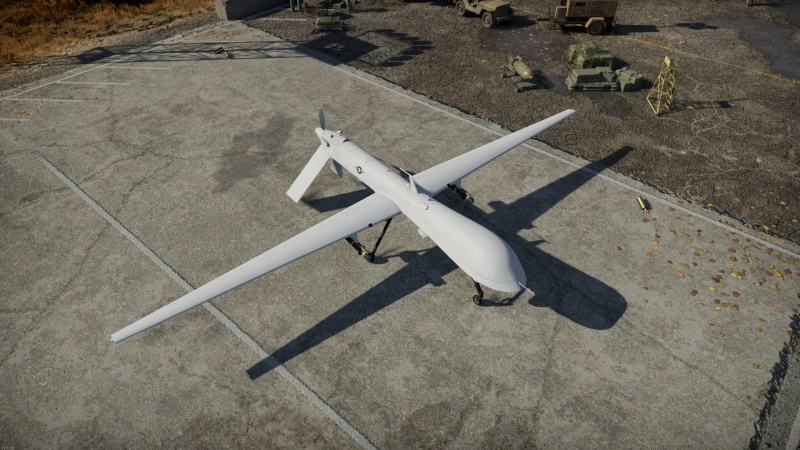Difference between revisions of "MQ-1"
(→Description) |
U120313908 (talk | contribs) (→History: Greatly expanded) (Tag: Visual edit) |
||
| Line 99: | Line 99: | ||
== History == | == History == | ||
| − | <!-- ''Describe the history of the creation and combat usage of the aircraft in more detail than in the introduction. If the historical reference turns out to be too long, take it to a separate article, taking a link to the article about the vehicle and adding a block "/History" (example: <nowiki>https://wiki.warthunder.com/(Vehicle-name)/History</nowiki>) and add a link to it here using the <code>main</code> template. Be sure to reference text and sources by using <code><nowiki><ref></ref></nowiki></code>, as well as adding them at the end of the article with <code><nowiki><references /></nowiki></code>. This section may also include the vehicle's dev blog entry (if applicable) and the in-game encyclopedia description (under <code><nowiki>=== In-game description ===</nowiki></code>, also if applicable).'' --> | + | <!-- ''Describe the history of the creation and combat usage of the aircraft in more detail than in the introduction. If the historical reference turns out to be too long, take it to a separate article, taking a link to the article about the vehicle and adding a block "/History" (example: <nowiki>https://wiki.warthunder.com/(Vehicle-name)/History</nowiki>) and add a link to it here using the <code>main</code> template. Be sure to reference text and sources by using <code><nowiki><ref></ref></nowiki></code>, as well as adding them at the end of the article with <code><nowiki><references /></nowiki></code>. This section may also include the vehicle's dev blog entry (if applicable) and the in-game encyclopedia description (under <code><nowiki>=== In-game description ===</nowiki></code>, also if applicable).'' -->The MQ-1 Predator was an unmanned vehicle, developed by General Atomics for the USAF in the 1990s. General Atomics was selected for the development of the aircraft in 1994 with it's first flight in the 3rd of July, 1994 at El Mirage Airfield in Mojave Desert. The aircraft had a lot of similarities to the General Atomics Gnat 750, which was a reconnaissance drone developed in the late 1980s. |
| − | The MQ-1 | + | The aircraft participated in different exercises in 1995 as part of its ACTD (Advanced Concept Technology Demonstration). In this stage, it was flown by members of the Navy, USAF, Army and the Marines Corp with successful results. |
| + | |||
| + | This lead to the decision to deploy the MQ-1 in 1995 as part of the peacekeeping missions in the Balkans, thus it was deployed in Albania and former Yugoslavia. Its first deployment in mass was during the Afghan Campaign of 2001. At that point the US had 60 Predators in service but 20 were lost in action during the campaign. However soon problems started to appear, since most of these losses were not due to enemy fire, instead they happened because of reliability problems. The aircraft struggled with icy and cold weather conditions, which are normal in the mountains of Afghanistan. Thus the aircrafts development went further, incorporating a de-icing system, upgraded turbocharger and improved avionics in what was called the Block 1 or MQ-1L. | ||
| + | |||
| + | Its armed version, known as RQ-1 in the development process, incorporated pylons for guided ammunitions such as laser guided missiles, like the Hellfire ATGM. Several tests were carried during early 2000s with good results and several simulated targets being destroyed by the Predator. These Predator models were put into service with the designation MQ-1A. Other tests occurred during 2001 after the CIA advocated to use the Hellfire armed version of the Predator to target high value targets like Osama Bin Laden. However these tests showed mixed results, because of issues with the missile fuze that were later resolved. This version however was only deployed to Afghanistan after the September 11 incident. | ||
| + | |||
| + | The Predator as a platform showed good results, being the main UAV in service with the USAF and other branches of the US Armed Forces until the arrival of the MQ-9 Reaper, which was itself a further development of the MQ-1. The aircraft was developed to the Balkans, Afghanistan, Pakistan, Iraq, Yemen, Libya, Syria and several other locations were it was used not only in military operations but also as a counter terrorist weapon. Because of its unmanned nature, it was safer to use drones like the Predator to find and later execute any target without risking the lives of pilots or ground forces in the process. | ||
| + | |||
| + | The Predator remained in limited service up to 2018 when it was completely retired in favour of the more heavier and capable MQ-9 Reaper, but it didn't only flew for the US Armed Forces. The Italian Armed Forcers signed a contract for 6 x MQ-1A Predator drones in 2002 with the units being delivered in 2004. These units were used in Afghanistan, Djibouti and Iraq with more than 8000h of flight. Licenses for it's sale were also given to Saudi Arabia, the UAE, Morocco and Egypt. | ||
== Media == | == Media == | ||
Revision as of 19:48, 23 September 2023
Contents
Description
The MQ-1 is an American strike UCAV (Unmanned Combat Aerial Vehicle), developed by General Atomics Aeronautical Systems. Developed from the General Atomics Gnat 750, the "Predator", as the MQ-1 was named, would go on to serve in many conflicts around the world, including in Bosnia, Yugoslavia, Afghanistan, Iraq, and Libya, to name a few. It served extensively from 1995 until 2018, after which it was replaced by the MQ-9 "Reaper".
The Predator was introduced in Update "Drone Age". All nations besides Russia and China gain access to this vehicle to spawn for 750 spawn points; this is not a researchable vehicle. This vehicle is useful in cases where other CAS is unavailable or unable to be used, for example in night battles. With 2 Hellfires, the arsenal is limited, though the drone can be useful to locate enemy vehicles once dry of missiles, with the excellent optical zoom and thermals.
General info
Flight performance
| Max speed (km/h at 1,000 m) |
Max altitude (metres) |
Turn time (seconds) |
Rate of climb (metres/second) |
Take-off run (metres) | |||
|---|---|---|---|---|---|---|---|
| AB | RB | AB | RB | AB | RB | ||
| 220 | 220 | 22.0 | 22.0 | 2.5 | 2.5 | 250 | |
Details
| Features | ||||
|---|---|---|---|---|
| Combat flaps | Take-off flaps | Landing flaps | Air brakes | Arrestor gear |
| X | X | X | X | X |
| Limits | ||||||
|---|---|---|---|---|---|---|
| Wings (km/h) | Gear (km/h) | Flaps (km/h) | Max Static G | |||
| Combat | Take-off | Landing | + | - | ||
| 390 | N/A | N/A | N/A | ~__ | ~__ | |
| Optimal velocities (km/h) | |||
|---|---|---|---|
| Ailerons | Rudder | Elevators | Radiator |
| < ___ | < ___ | < ___ | > ___ |
Survivability and armour
Examine the survivability of the aircraft. Note how vulnerable the structure is and how secure the pilot is, whether the fuel tanks are armoured, etc. Describe the armour, if there is any, and also mention the vulnerability of other critical aircraft systems.
Armaments
Suspended armament
The MQ-1 can be outfitted with the following ordnance:
- 2 x AGM-114K Hellfire II missiles
Usage in battles
Describe the tactics of playing in the aircraft, the features of using aircraft in a team and advice on tactics. Refrain from creating a "guide" - do not impose a single point of view, but instead, give the reader food for thought. Examine the most dangerous enemies and give recommendations on fighting them. If necessary, note the specifics of the game in different modes (AB, RB, SB).
Pros and cons
Pros:
- High altitude spawn, above most radars at its battle rating
- The Hellfire missiles are accurate and have a long range
- Can carry a lot of fuel
Cons:
- Limited payload, only two missiles
- Slow
History
The MQ-1 Predator was an unmanned vehicle, developed by General Atomics for the USAF in the 1990s. General Atomics was selected for the development of the aircraft in 1994 with it's first flight in the 3rd of July, 1994 at El Mirage Airfield in Mojave Desert. The aircraft had a lot of similarities to the General Atomics Gnat 750, which was a reconnaissance drone developed in the late 1980s.
The aircraft participated in different exercises in 1995 as part of its ACTD (Advanced Concept Technology Demonstration). In this stage, it was flown by members of the Navy, USAF, Army and the Marines Corp with successful results.
This lead to the decision to deploy the MQ-1 in 1995 as part of the peacekeeping missions in the Balkans, thus it was deployed in Albania and former Yugoslavia. Its first deployment in mass was during the Afghan Campaign of 2001. At that point the US had 60 Predators in service but 20 were lost in action during the campaign. However soon problems started to appear, since most of these losses were not due to enemy fire, instead they happened because of reliability problems. The aircraft struggled with icy and cold weather conditions, which are normal in the mountains of Afghanistan. Thus the aircrafts development went further, incorporating a de-icing system, upgraded turbocharger and improved avionics in what was called the Block 1 or MQ-1L.
Its armed version, known as RQ-1 in the development process, incorporated pylons for guided ammunitions such as laser guided missiles, like the Hellfire ATGM. Several tests were carried during early 2000s with good results and several simulated targets being destroyed by the Predator. These Predator models were put into service with the designation MQ-1A. Other tests occurred during 2001 after the CIA advocated to use the Hellfire armed version of the Predator to target high value targets like Osama Bin Laden. However these tests showed mixed results, because of issues with the missile fuze that were later resolved. This version however was only deployed to Afghanistan after the September 11 incident.
The Predator as a platform showed good results, being the main UAV in service with the USAF and other branches of the US Armed Forces until the arrival of the MQ-9 Reaper, which was itself a further development of the MQ-1. The aircraft was developed to the Balkans, Afghanistan, Pakistan, Iraq, Yemen, Libya, Syria and several other locations were it was used not only in military operations but also as a counter terrorist weapon. Because of its unmanned nature, it was safer to use drones like the Predator to find and later execute any target without risking the lives of pilots or ground forces in the process.
The Predator remained in limited service up to 2018 when it was completely retired in favour of the more heavier and capable MQ-9 Reaper, but it didn't only flew for the US Armed Forces. The Italian Armed Forcers signed a contract for 6 x MQ-1A Predator drones in 2002 with the units being delivered in 2004. These units were used in Afghanistan, Djibouti and Iraq with more than 8000h of flight. Licenses for it's sale were also given to Saudi Arabia, the UAE, Morocco and Egypt.
Media
Excellent additions to the article would be video guides, screenshots from the game, and photos.
See also
Links to the articles on the War Thunder Wiki that you think will be useful for the reader, for example:
- reference to the series of the aircraft;
- links to approximate analogues of other nations and research trees.
External links
| General Atomics Aeronautical Systems, Inc. (GA-ASI) | |
|---|---|
| Drones | MQ-1 |
| Strike UCAVs | |
|---|---|
| USA | MQ-1 |
| USSR | Orion |
| China | Wing Loong I |





